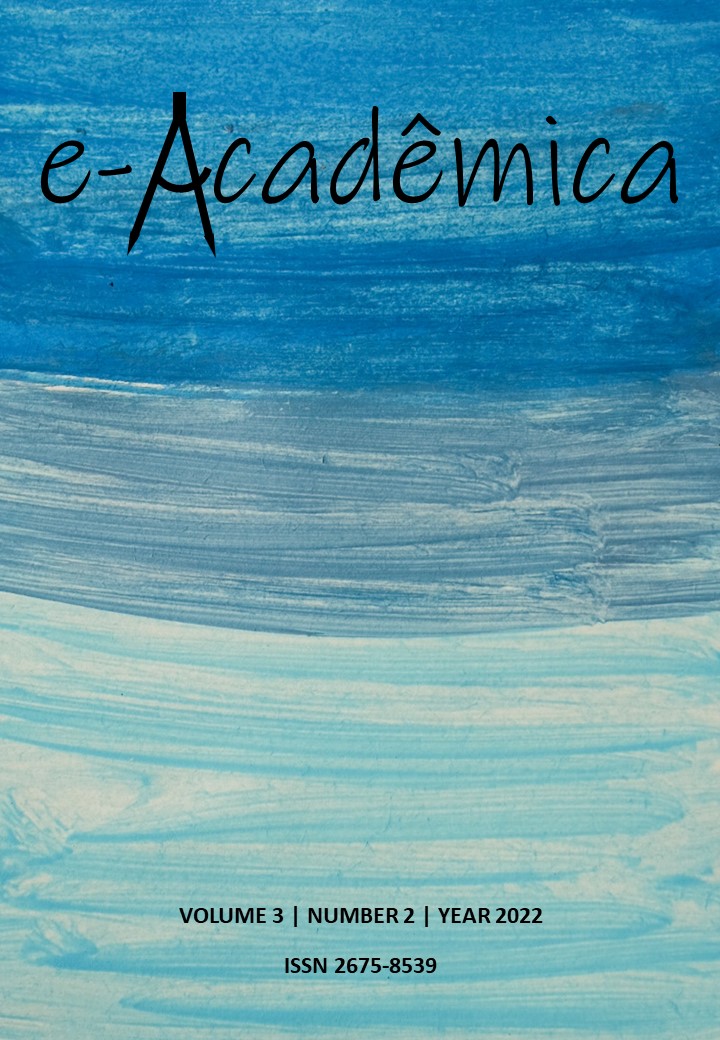Water balance and its comparison with 1996-2005, 2006-2015 compared to 2015 in the municipality of São Bento do Uma - PE
DOI:
https://doi.org/10.52076/eacad-v3i2.226Keywords:
Evapotranspiration; Rain Distribution.Abstract
It is important to know the rainfall distribution and its variability in a region, aiming, therefore, to evaluate the periods of deficiency, surplus, withdrawal and replacement of water for the agricultural, agribusiness and poultry sectors, aiming at the water demand, since the water balance of the point from an agronomic point of view offers this planning. The rainfall data were acquired from the Superintendence of the Development of the Northeast and from the Pernambucana Water and Climate Agency between the years 1920 to 2016. Simplified calculations were used to define, mean, standard deviation, coefficient of variance, maximum and minimum absolute values occurred, the rainy and dry seasons were defined. The temperatures were estimated by the methods of the multiple regression line taking into account the geographic coordinates. The analyzed parameters indicate insufficient conditions for the development of certain cultures and the sustainability of the development in the production of poultry with special care in the storage, damming and distribution of water in the drinkers since the temperature is high. The analysis of the spatial and temporal variability of rainfall provides information on how rural and urban people should establish measures for capturing rainwater and storing it using the wettest period. It appears that there were no water surpluses in the years studied, the values of deficiencies were more significant in the year 2011 than in the period 1926-2010. Potential evapotranspiration was higher in 2011; there was an increase in precipitation of 159.9mm in 2011.
References
AMORIM, R.C.F.; RIBEIRO, A.; LEITE, C.C.; LEAL, B.G. & SILVA, J.B.G. (2008). Avaliação do desempenho de dois métodos de espacialização da precipitação pluvial para o Estado de Alagoas. Acta Scientiarum. Technology, v.30, n. 1, p. 87-91.
ALVARES, C.A.; STAPE, J.L.; SENTELHAS, P.C.; GONÇALVES, J.L.M. & SPAROVEK, G. (2014). Köppen's climate classification map for Brazil. Meteorologische Zeitschrift 22, 711–728.
APAC. Agência pernambucana de água e clima. 2016.
ARRAES, F.D.D.; LOPES, F.B.; SOUZA, F.; & OLIVEIRA, J.B. (2009). Estimativa do Balanço Hídrico para as condições climáticas Iguatu, Ceará, usando Modelo Estocástico. Revista Brasileira de Agricultura Irrigada. Fortaleza, v.3, n.2, p.78–87.
CAMARGO, A.P. (1971). Balanço hídrico no Estado de São Paulo. Campinas: IAC, 28p. (Boletim Técnico, 116).
HOLANDA, R.M.; MEDEIROS, R.M. & SILVA, V.P.R. (2016). Recife-PE, Brasil e suas flutuabilidades da precipitação decadal. Natureza, Sociobiodiversidade e Sustentabilidade, 26 a 29 de outubro, 2016. Universidade Nacional, Sede Chorotega Nicoya, Costa Rica. P.230-245.
KÖPPEN, W.; GEIGER, R. (1928). “Klimate der Erde. Gotha: Verlag Justus Perthes”. Wall-map 150cmx200cm.
LAMEPE. Laboratório de meteorologia do Estado de Pernambuco.
LIMA, F.B.; SANTOS, G.O. (2009). Balanço hídrico-espacial da cultura para o uso e ocupação atual da bacia hidrográfica do Ribeirão Santa Rita, Noroeste do Estado de São Paulo. 2009. P.89. Monografia. Fundação Educacional de Fernandópolis, Fernandópolis - SP.
MATOS, R.M.; SILVA, J.A.S. & MEDEIROS, R.M. (2014). Aptidão climática para a cultura do feijão caupi do município de Barbalha – CE. Revista Brasileira de Agricultura Irrigada, v. 8, nº. 6, p. 422 - 431.
MEDEIROS, R.M.; AZEVEDO, P.V.; SABOYA, L.M F. Classificação climática e zoneamento agroclimático para o município de Amarante – PI. Revista Brasileira de Agricultura Irrigada, v. 7, n. 2, p. 170 - 180, 2013.
MEDEIROS, R.M. (2016). Programa do balanço hídrico segundo o método do balanço hídrico de Thornthwaite e Mather.
MEDEIROS, R.M. (2016). Classificação climática segundo modelo de Köppen para o estado de Pernambuco – Brasil.
MEDEIROS, R.M. (2016). Estudo climatológico do município de Matinhas – PB. Editora da Universidade Federal de Campina Grande - EDUFCG Universidade Federal de Campina Grande – UFCG. editora@ufcg.edu.br. p.150.
MEDEIROS, R.M. (2018). Estudo agrometeorológicos para o Estado do Pernambuco – Brasil, p135.
PEDDE, S. C.; KROEZE, R. L. N. (2013). Escassez hídrica na América do sul: situação atual e perspectivas futuras. XX Simpósio Brasileiro de Recursos Hídricos.
SANTOS, G. S.; NORI, P. G. & OLIVEIRA L. F. C. (2010). Chuvas intensas relacionadas à erosão hídrica. Revista Brasileira de Engenharia Agrícola e Ambiental, v.14, p.115-123.
SUDENE. (1990). Superintendência do Desenvolvimento do Nordeste - Dados pluviométricos mensais do Nordeste – Série pluviometria 5. Estado do Paraíba. Recife, 239p.
SOUSA, N.M.N.; DANTAS, R.T. & LIMEIRA, R.C. (2015). Influência de variáveis meteorológicas sobre a incidência do dengue, meningite e pneumonia em João Pessoa-PB. Revista Brasileira de Meteorologia, v.22, n.2, p. 183-192.
THORNTHWAITE, C. W. (1948). An approach toward a rational classification of climate. Geogr. Rev, v.38, p.55-94.
THORNTHWAITE, C. W.; MATHER, J. R. (1955). The water balance. Publications in Climatology. New Jersey: Drexel Institute of Technology, 104p.
Downloads
Published
How to Cite
Issue
Section
License
Copyright (c) 2022 Raimundo Mainar de Medeiros; Manoel Vieira de França; Luciano Marcelo Fallé Saboya; Romildo Morant de Holanda; Wagner Rodolfo de Araújo; Salatiel Ewen Braga

This work is licensed under a Creative Commons Attribution 4.0 International License.
Autores que publicam nesta revista concordam com os seguintes termos:
1) Autores mantém os direitos autorais e concedem à revista o direito de primeira publicação, com o trabalho simultaneamente licenciado sob a Licença Creative Commons Attribution que permite o compartilhamento do trabalho com reconhecimento da autoria e publicação inicial nesta revista.
2) Autores têm autorização para assumir contratos adicionais separadamente, para distribuição não-exclusiva da versão do trabalho publicada nesta revista (ex.: publicar em repositório institucional ou como capítulo de livro), com reconhecimento de autoria e publicação inicial nesta revista.
3) Autores têm permissão e são estimulados a publicar e distribuir seu trabalho online (ex.: em repositórios institucionais ou na sua página pessoal) a qualquer ponto antes ou durante o processo editorial, já que isso pode gerar alterações produtivas, bem como aumentar o impacto e a citação do trabalho publicado.










